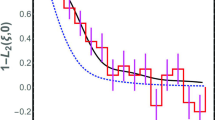Abstract
The applicability of models based on fractal geometry to length scales of nanometers is confirmed by Fourier analysis of scanning tunneling microscopy images of a sputter deposited gold film, a copper fatigue fracture surface, and a single crystal silicon fracture surface. Surfaces are characterized in terms of fractal geometry with a Fourier profile analysis, the calculations yielding fractal dimensions with high precision. Fractal models are shown to apply at length scales to 12 Å, at which point the STM tip geometry influences the information. Directionality and spatial variation of the topographic structures are measured. For the directions investigated, the gold and silicon appeared isotropic, while the copper fracture surface exhibited large differences in structure. The influences of noise in the images and of intrinsic mathematical scatter in the calculations are tested with profiles generated from fractal Brownian motion and the Weierstrass-Mandelbrot function. Accurate estimates of the fractal dimension of surfaces from STM data result only when images consist of at least 1000–2000 points per line and 1/f-type noise has amplitudes two orders of magnitude lower than the image signal. Analysis of computer generated ideal profiles from the Weierstrass-Mandelbrot function and fractional Brownian motion also illustrates that the Fourier analysis is useful only in determining the local fractal dimension. This requirement of high spatial resolution (vertical information density) is met by STM data. The fact that fractal models can be used at lengths as small as nanometers implies that continued topographic structural analyses may be used to study atomistic processes such as those occurring during fracture of elastic solids.
Similar content being viewed by others
References
P. Pfeifer, Appl. of Surf. Sci. 18, 146–164 (1984).
B. Mandelbrot, Fractal Geometry of Nature (W. H. Freeman & Co., San Francisco, CA, 1982).
J. Feder, Fractals (Plenum Press, New York, 1988).
J. J. Mecholsky, T. Mackin, and D. E. Passoja, Adv. in Cer. Vol. 22: Fractography of Glasses and Ceramics (American Ceramic Society, Inc., 1988), pp. 127–134.
D. E. Passoja, Adv. in Cer. Vol. 22: Fractography of Glasses and Ceramics (American Ceramic Society, Inc., 1988), pp. 127–134.
D. E. Passoja and D. J. Amborski, “Fracture Profile Analysis by Fourier Transform Methods”.
B. Mandelbrot, D. Passoja, and A. Paullay, Nature 308, 721–722 (1984).
E. Underwood and K. Banerji, Mat. Sci. and Eng. 80, 1–14 (1986).
G. Binnig and H. Rohrer, Helv. Phys. Acta 55, 726–729 (1982).
See, for example, a number of papers in Proc. Int. Conf. on STM 1987, edited by R. Feenstra, J. Vac. Sci. and Technol., 257–556 (1988).
D. A. Bonnell and D.R. Clarke, J. Am. Ceram. Soc. 71 629–637 (1988).
D. A. Bonnell, Mat. Sci. and Eng. A105/106, 55–63 (1988).
D. A. Bonnell and M. Angelopoulos, Synth. Met. 33, 301–310 (1989).
R. Voss, in Fundamental Algorithms for Computer Graphics, edited by R. A. Earnshaw (Springer-Verlag, New York, 1985), pp. 805–835.
W. H. Press, B. P. Flannery, S. A. Teukolsky, and W.T. Vettering, Numerical Recipes (Cambridge University Press, Cambridge, U.K., 1986), pp. 381–453.
M.V. Berry and Z.V. Lewis, Proc. R. Soc. London 370, 459–484 (1980).
M. Coster and J. L. Chermat, Int. Met. Rev. 28, 228–250 (1983).
B. Dubuc, J. F. Quiniou, C. Rouques-Carmes, C. Tricot, and S.W. Zucker, Phys. Rev. A 39, 1500–1512 (1989).
E. Stoll and O. Marti, Surf. Sci. 181, 222–229 (1987).
P. Meakin, R. Ramanlal, L. M. Sander, and R. C. Ball, Phys. Rev. A 34, 5091–5103 (1986).
F. Family and T. Vicsek, J. Phys. A 18, L75 (1984).
M. Kardar, G. Parisi, and Y. C. Zhang, Phys. Rev. Lett. 56, 889 (1986).
P. Meakin and R. Jullien, Europhys. Lett. 9, 71–76 (1989).
R. E. Williford, Scripta Metall. 22, 149–154 (1988).
Author information
Authors and Affiliations
Rights and permissions
About this article
Cite this article
Mitchell, M.W., Bonnell, D.A. Quantitative topographic analysis of fractal surfaces by scanning tunneling microscopy. Journal of Materials Research 5, 2244–2254 (1990). https://doi.org/10.1557/JMR.1990.2244
Received:
Accepted:
Published:
Issue Date:
DOI: https://doi.org/10.1557/JMR.1990.2244




